|
BATTLE OF MAL TIEMPO (BATALLA DE MAL TIEMPO)
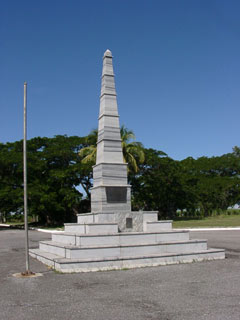 This historical site, located in the municipality of Cruces, is within a park surrounded by a paved area that acts as an access to the obelisk. It has a stepped structure in a pyramidal form, and is located at the centre of the park surrounded by colonial ruins.
On December 15th of 1895, the invading column of Maceo and Gómez started moving in order to penetrate the territory of Cienfuegos; and made camp in Cruces, an important sugar region of the country’s central area.
In the settlement next to Mal Tiempo, the Spanish columns that were trying to cut off the advance of the Mambi troops, were attacked by the Cuban forces, producing a great battle in the middle of the Cienfuegos lands. This military and political feat covered the Invading Army (Ejército Invasor) with glory and dealt a hard blow to Spain’s aspirations of quenching the insurrectional struggle along the length of the island.
It was declared a National Monument on December 15th of 1981.
This historical site, located in the municipality of Cruces, is within a park surrounded by a paved area that acts as an access to the obelisk. It has a stepped structure in a pyramidal form, and is located at the centre of the park surrounded by colonial ruins.
On December 15th of 1895, the invading column of Maceo and Gómez started moving in order to penetrate the territory of Cienfuegos; and made camp in Cruces, an important sugar region of the country’s central area.
In the settlement next to Mal Tiempo, the Spanish columns that were trying to cut off the advance of the Mambi troops, were attacked by the Cuban forces, producing a great battle in the middle of the Cienfuegos lands. This military and political feat covered the Invading Army (Ejército Invasor) with glory and dealt a hard blow to Spain’s aspirations of quenching the insurrectional struggle along the length of the island.
It was declared a National Monument on December 15th of 1981.
Pour davantage d'information:
www.cuba-geography.com
,
www.cuba-heroes.com
,
www.cuba-history.com
,
www.cuba-cienfuegos.com
|
|
|
CHÂTEAU DE JAGUA
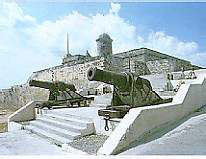 Un des attraits touristiques de la ville de Cienfuegos. Sa construction fut terminée en 1745 et il fut inauguré avec le nom de Château de Notre Dame des Anges de Jagua. Il possède une tour de basa circulaire avec des meurtrières verticales et étroites. Sa majestueuse coupole possède un soupirail qui ressemble à un oeuil alerte sur les eaux marines toujours tranquilles. Cet attrayant château a fait l’objet d’une restauration fidèle et le visiteur pourra apprécier la chapelle originale dans toute sa splendeur ainsi que ses cellules humides, son fossé profond impossible à passer si le pont-levis qui permet l’entré à son enceinte emmuraillée est levé, tout ceci en écoutant les délicieuses légendes du lieu. Le petit et bel édifice, voisin de l’hôtel Jagua s’élève à la fin du Prado (Promenade) de Cienfuegos, il à le titre de Monument National.
Un des attraits touristiques de la ville de Cienfuegos. Sa construction fut terminée en 1745 et il fut inauguré avec le nom de Château de Notre Dame des Anges de Jagua. Il possède une tour de basa circulaire avec des meurtrières verticales et étroites. Sa majestueuse coupole possède un soupirail qui ressemble à un oeuil alerte sur les eaux marines toujours tranquilles. Cet attrayant château a fait l’objet d’une restauration fidèle et le visiteur pourra apprécier la chapelle originale dans toute sa splendeur ainsi que ses cellules humides, son fossé profond impossible à passer si le pont-levis qui permet l’entré à son enceinte emmuraillée est levé, tout ceci en écoutant les délicieuses légendes du lieu. Le petit et bel édifice, voisin de l’hôtel Jagua s’élève à la fin du Prado (Promenade) de Cienfuegos, il à le titre de Monument National.
Pour davantage d'information:
www.cuba-history.com
,
www.cuba-cienfuegos.com
|
|
|
CIENFUEGOS
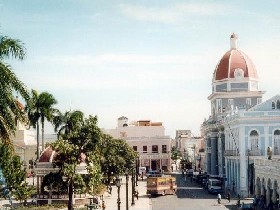 Se trouvant à 244 kilomètres de la capitale, dans la région centre sud du pays, cette ville compte sur la belle Baie de Jagua, dont les eaux profondes abondent de Sabalo, une espèce recherchée par les connaisseurs de la pêche.
Traditionnellement des tournois de pêche y ont lieu et ses plages de Rancho Luna et El Inglés sont des lieux propices à la plongée et à l’observation des splendides coraux marins, avec entre autre le Notre Dame de six mètres de hauteur.
La bien nommée Perla del Sur (Perle du Sud, fondée par des français en 1880. Il est significatif que cette ville du 19éme siècle conserve son atout principal dans son centre historique, lequel est constitué d’un ensemble d’édifications aux grandes colonnes et amples porches, donnant ainsi l’air traditionnel qui l’enveloppe dans un environnement ou ressort l’hygiène et la propreté. Son centre historique est considéré Monument National.
Cienfuegos possède toute l’infrastructure nécessaire pour obtenir de haut indices de satisfaction au près des touristes qui la choisiront parmi leurs destinations à Cuba.
Se trouvant à 244 kilomètres de la capitale, dans la région centre sud du pays, cette ville compte sur la belle Baie de Jagua, dont les eaux profondes abondent de Sabalo, une espèce recherchée par les connaisseurs de la pêche.
Traditionnellement des tournois de pêche y ont lieu et ses plages de Rancho Luna et El Inglés sont des lieux propices à la plongée et à l’observation des splendides coraux marins, avec entre autre le Notre Dame de six mètres de hauteur.
La bien nommée Perla del Sur (Perle du Sud, fondée par des français en 1880. Il est significatif que cette ville du 19éme siècle conserve son atout principal dans son centre historique, lequel est constitué d’un ensemble d’édifications aux grandes colonnes et amples porches, donnant ainsi l’air traditionnel qui l’enveloppe dans un environnement ou ressort l’hygiène et la propreté. Son centre historique est considéré Monument National.
Cienfuegos possède toute l’infrastructure nécessaire pour obtenir de haut indices de satisfaction au près des touristes qui la choisiront parmi leurs destinations à Cuba.
Pour davantage d'information:
www.cuba-perladelsur.com
,
www.cuba-cienfuegos.com
|
|
|
CIENFUEGOS BOTANICAL GARDENS
The Cienfuegos Botanical Gardens (JBC) is one of the favourites of both Cubans and foreign visitors, due to its unrivalled quality of being the country’s most ancient as well as exhibiting plant collections from the world’s five continents.
Last year, over 35 thousand people enjoyed the leafy families of bamboos, orchids and palms, these last are considered among the most complete in the world.
Internationally acclaimed as one of the best tropical gardens in the world, it possesses an astounding variety of over two thousand species, and is nearing its 104th birthday. It even has a specialised herbarium with regional flowers and herbs.
This green kingdom generates much research, such as studies to revitalise endangered species, and programmes to stimulate interest for blind children as well as community projects with retarded children and those that suffer from Down’s syndrome.
The southern park, created first for sugar cane research, and later for developing fruit and hardwood trees, became an area for gathering knowledge and teaching about the planet’s flora, including a conservation area for exotic plants.
Pour davantage d'information:
www.cuba-flora.com
,
www.cuba-history.com
,
www.cuba-cienfuegos.com
|
|
|
CIMETIÈRE GENERAL DE CIENFUEGOS
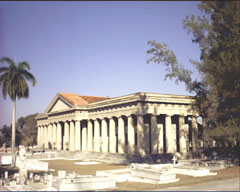 De par sa grande valeur historique, il se trouve parmi les sites ou constructions conçus comme Monuments Nationaux. Il est aussi connu comme « Cimetière de Reina » et 20 ans après sa fondation il fut le premier du bourg du sud, devenu aujourd’hui la fameuses ville, où se mêlent les architectures des 19, 20, et 21ème siècles. Selon les spécialistes, les pierres tombales des niches sont de véritables trésors de l’art sculptural en bas relief et une grande partie des sculptures de marbres ont la même valeur, parmi elles, La Belle Au Bois Dormant, de la légende populaire. Les extérieurs du cimetière se font remarquer de par leurs grilles en fer forgé, véritables œuvres qui portent bien haut le niveau des artisans qui les conçurent il y a plus de 150 ans.
De par sa grande valeur historique, il se trouve parmi les sites ou constructions conçus comme Monuments Nationaux. Il est aussi connu comme « Cimetière de Reina » et 20 ans après sa fondation il fut le premier du bourg du sud, devenu aujourd’hui la fameuses ville, où se mêlent les architectures des 19, 20, et 21ème siècles. Selon les spécialistes, les pierres tombales des niches sont de véritables trésors de l’art sculptural en bas relief et une grande partie des sculptures de marbres ont la même valeur, parmi elles, La Belle Au Bois Dormant, de la légende populaire. Les extérieurs du cimetière se font remarquer de par leurs grilles en fer forgé, véritables œuvres qui portent bien haut le niveau des artisans qui les conçurent il y a plus de 150 ans.
Pour davantage d'information:
www.cuba-history.com
,
www.cuba-cienfuegos.com
,
www.cuba-cemeteries.com
|
|
|
JARDIN BOTANIQUE, CIENFUEGOS
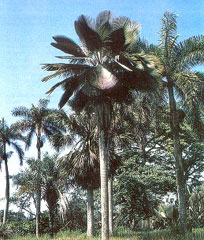 L’institution centenaire est la plus ancienne en son genre dans le pays et offre au visiteur national ou étranger la possibilité d’admirer des plantes bien soignées et originaires des quatre coins du monde. L’incomparable vert tropical se fait seigneur du Jardin Botanique de la bien nommée Perle du Sud et sa collection de palmiers est très complète au point que certains experts considèrent qu’il s’agit d’une des plus complètes de l’univers. Plus d’un millier d’espèces qui vont de l’exubérant Fromager jusqu’à un herbier contenant de nombreuses variétés de la splendide flore caribéenne. Ce majestueux parc de Cienfuegos thésaurise d’innombrables espèces d’arbres à bois et fruitiers, ainsi qu’une aire pour la conservation de plantes exotiques. En fin, de par tous ses attributs ce Jardin Botanique est Monument National.
L’institution centenaire est la plus ancienne en son genre dans le pays et offre au visiteur national ou étranger la possibilité d’admirer des plantes bien soignées et originaires des quatre coins du monde. L’incomparable vert tropical se fait seigneur du Jardin Botanique de la bien nommée Perle du Sud et sa collection de palmiers est très complète au point que certains experts considèrent qu’il s’agit d’une des plus complètes de l’univers. Plus d’un millier d’espèces qui vont de l’exubérant Fromager jusqu’à un herbier contenant de nombreuses variétés de la splendide flore caribéenne. Ce majestueux parc de Cienfuegos thésaurise d’innombrables espèces d’arbres à bois et fruitiers, ainsi qu’une aire pour la conservation de plantes exotiques. En fin, de par tous ses attributs ce Jardin Botanique est Monument National.
Pour davantage d'information:
www.cuba-botanicalgardens.com
,
www.cuba-flora.com
,
www.cuba-cienfuegos.com
|
|
|
MARTÍN INFIERNO CAVERN
This important natural site is a cavern of enormous dimensions, whose initial formation dates back to the Pliocene Pleistocene. It is found in the upper part of Río Hondo, which drains its waters towards the southern coast. This is part of the northern slope of the Guamuaya mountain massif, in the municipality of Cumanayagua.
The cavern features the tallest stalagmite in Cuba and one of the largest in the world, according to the Speleologic Society of Cuba who carried out the measurement, its official height is 67,2 m.
It has a very large inclined cavity, with five great halls of vast proportions, that together with the rest of the galleries, sum up a linear total of 793 m and an off-level of 190 m.
Inside one can find the only “gypsum flowers” ("flores de yeso") reported in Cuban territory. They measure over 30 cm, and resemble a helicoidal or rolled up shape giving the impression of a flower. Also reported is the presence of another mineral rarity, that is formed by microcrystalline calcite known as "moon milk".
This is a site of infinite scientific discovery for learning about the evolution of the territory, due to the characteristics of the deposits that are found inside, as well as the evidence of endangered fauna such as the tocororo, the sijú owl and the Cuban kites and mountain hawks.
Pour davantage d'information:
www.cuba-ecotourism.com
,
www.cuba-geography.com
,
www.cuba-cienfuegos.com
|
|
|
PARC MARTÍ, CIENFUEGOS
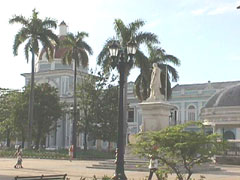 Il adopte le nom du Héro National en 1906, après qu’ait été érigé l’ensemble sculptural central, idée de l’artiste italien Giovani Nocolini et 14 ans plus tard fut posé le piédestal sur lequel repose la statue qui symbolise la République. Ce parc est, depuis 1865, embelli par la présence de deux lions sculptés en marbre. L’Arc des Ouvriers est de la même époque et fut élevé dans une de ses entrées par l’Association des Maçons. Les habitants de Cienfuegos montrent aussi avec orgueil la gloire et les bustes qui embellissent l’environnement de ce parc bien soigné, devenu centre obligatoire d’attention de par la position centrale qu’il occupe et qui possède, de plus, le titre de Monument National.
Il adopte le nom du Héro National en 1906, après qu’ait été érigé l’ensemble sculptural central, idée de l’artiste italien Giovani Nocolini et 14 ans plus tard fut posé le piédestal sur lequel repose la statue qui symbolise la République. Ce parc est, depuis 1865, embelli par la présence de deux lions sculptés en marbre. L’Arc des Ouvriers est de la même époque et fut élevé dans une de ses entrées par l’Association des Maçons. Les habitants de Cienfuegos montrent aussi avec orgueil la gloire et les bustes qui embellissent l’environnement de ce parc bien soigné, devenu centre obligatoire d’attention de par la position centrale qu’il occupe et qui possède, de plus, le titre de Monument National.
Pour davantage d'information:
www.cuba-cienfuegos.com
|
|
|
REMAINS OF THE TRAIL (TROCHA) FROM JÚCARO TO MORÓN
A brief history of the Trail (Trocha) from Júcaro to Morón.
In the wars of 1868 and 1895, the Trocha was an insurmountable barrier, as the Spanish thought, and after it was finished, it became the most perfect and sophisticated military construction that the Spanish Colonialism had in America. Of course it was never a deterrent for the glorious Mambi Army (Ejército Mambí), who in both wars kept crossing it ,showing the ingenious strategies deployed by their military chiefs, among them Máximo Gómez and Antonio Maceo, with the help of other insurrectional chiefs of the area, such as Brigadier José Gómez Cardoso and Colonel Simón Reyes Hernández, known as the Eagle of the Trocha (El Águila de la Trocha).
The aim of this military line was to isolate the mambi forces in the eastern area, in order to deter help and break contact between the insurrectional forces in the central and eastern regions, and to stop the invaders, led by Máximo Gómez and Antonio Maceo from extending the war to the western region of the country, an event that would wear down the strength of Spanish colonialism, leading up to its final fall.
By the end of March of 1871, three years from the Cry of Yara (Grito de Yara), General Blas Villate de la Hera, Count of Valmaseda, proposed to the Overseas Minister of the Spanish Crown; the construction of a trocha or fortified line, from the port of Júcaro, on the southern coast; running across the island, to the settlement of Morón, on the northern coast.
Valmaseda’s proposal was approved, and construction on the trocha was started. It started out with 17 fortresses and in 1874, 16 bunkers had been added on, more than five thousand men were employed to guard it, these soldiers had modern infantry weapons as well as ten pieces of artillery, which were moved along the Trocha by a narrow railway, which also allowed them to quickly move the troops from one end to the other.
Pour davantage d'information:
www.cuba-heroes.com
,
www.cuba-history.com
,
www.cuba-matanzas.com
,
www.cuba-cienfuegos.com
,
www.cuba-villaclara.com
,
www.cuba-sanctispiritus.com
|
|
|
SANTA ISABEL DE LAS LAJAS
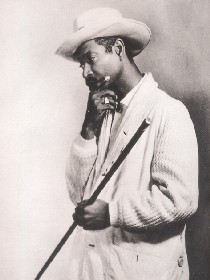 This is where Bartolomé “Benny” Moré was born, a man who became the most popular singer of boleros, sones and guarachas in the history of Cuban music.
Without studying music, he was able to write quite a number of songs and compositions, that came to life by way of the orchestra that he directed during the last years of his turbulent life.
Benny, among his vast repertoire, dedicated a song to his homeland and another to the neighbouring city of Cienfuegos.
This is where Bartolomé “Benny” Moré was born, a man who became the most popular singer of boleros, sones and guarachas in the history of Cuban music.
Without studying music, he was able to write quite a number of songs and compositions, that came to life by way of the orchestra that he directed during the last years of his turbulent life.
Benny, among his vast repertoire, dedicated a song to his homeland and another to the neighbouring city of Cienfuegos.
Pour davantage d'information:
www.cuba-perladelsur.com
,
www.cuba-cienfuegos.com
|
|
|
URBAN RESIDENTIAL AREA OF PUNTA GORDA, CIENFUEGOS
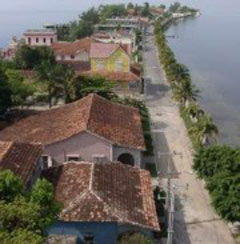 A residential area to the south of the city, whose wooden architecture is a true expression of the American “balloon flame” style, is considered a National Monument.
To the south of the city of Cienfuegos is a residential area known as “La Punta”, and known as “Punta Gorda” in the last century; with only one road access, determined by the physical form of the territory. It is characterised by its formal buildings (with a strong influence of Caribbean and American wooden architecture), their location within the lots of land and its natural and man-made surroundings.
In its beginnings, La Punta belonged to the old Party of ¨Padre de las Casas¨, ¨Las Calabazas¨ quarter and was recognised as Tureira. It had always been a summer site for vacationers, which is evidenced in the large number of houses built for renting during the summer season, which is the reason for the variety of owners, although some owners did live there on a permanent basis. Most of these houses had their own private docks at the back, or leading out towards 35th street (Gazel), these docks had verandas and small shacks beautifully worked in wood.
There were many recreational activities carried out in the area. Near Villa Elena the first tennis court was built. The families used to take a ride on motorboats or yachts, and in the afternoons they would visit the tidal flats, coves, the ¨Caletón de Don Bruno¨ and the mouths of the rivers. A wide dock was built, called “royal” by some, right across the street from the intersection of what is today Avenida 0 and 35th street, the steam ships began to dock here, including a river boat called Damují. All the sea baths were completely closed off, with shacks or tiled roofs in order for swimmers to rest in the shade.
A residential area to the south of the city, whose wooden architecture is a true expression of the American “balloon flame” style, is considered a National Monument.
To the south of the city of Cienfuegos is a residential area known as “La Punta”, and known as “Punta Gorda” in the last century; with only one road access, determined by the physical form of the territory. It is characterised by its formal buildings (with a strong influence of Caribbean and American wooden architecture), their location within the lots of land and its natural and man-made surroundings.
In its beginnings, La Punta belonged to the old Party of ¨Padre de las Casas¨, ¨Las Calabazas¨ quarter and was recognised as Tureira. It had always been a summer site for vacationers, which is evidenced in the large number of houses built for renting during the summer season, which is the reason for the variety of owners, although some owners did live there on a permanent basis. Most of these houses had their own private docks at the back, or leading out towards 35th street (Gazel), these docks had verandas and small shacks beautifully worked in wood.
There were many recreational activities carried out in the area. Near Villa Elena the first tennis court was built. The families used to take a ride on motorboats or yachts, and in the afternoons they would visit the tidal flats, coves, the ¨Caletón de Don Bruno¨ and the mouths of the rivers. A wide dock was built, called “royal” by some, right across the street from the intersection of what is today Avenida 0 and 35th street, the steam ships began to dock here, including a river boat called Damují. All the sea baths were completely closed off, with shacks or tiled roofs in order for swimmers to rest in the shade.
Pour davantage d'information:
www.cuba-culturaltours.com
,
www.cuba-geography.com
,
www.cuba-perladelsur.com
,
www.cuba-cienfuegos.com
|
|
|
Yaguaramas: the place where Henry Reeve, the Englishman (“El Inglesito”)fell in combat
It is a monument located along the road of Yaguaramas to Horquita, Abreus
At the place called "El Cayo del Inglés", between Yaguaramas and Horquita, in the municipality of Abreus, a modest monument was erected in memory of the place where Henry Reeve "El Inglesito", brigadier of the Liberating Army (Ejército Libertador) fell in combat, in August of 1876.
The Obelisk, in the shape of a column of solid concrete in square sections, has an irregular wall at the back and stone paved walkway. The whole place is surrounded by lush green lawns.
Considered by the Spanish as one of the most talented, brave and honourable Mambi chiefs, he was born in Brooklyn, United States and travelled to Cuba on board the steamboat "Perrit", commandeered by the American General Thomas Jordan. They were discovered, attacked and dispersed by the Spanish forces when they were docking near Banes, in the western part (Oriente) of the Island.
Reeve managed to escape and soon joined the legendary cavalry of Camaguey, led by the Major General Ignacio Agramonte “Bayardo”, of whom he became field assistant, taking part in many combats, among them the rescue of Brigadier Julio Sanguily.
Pour davantage d'information:
www.cuba-geography.com
,
www.cuba-heroes.com
,
www.cuba-history.com
,
www.cuba-cienfuegos.com
|
|
 This historical site, located in the municipality of Cruces, is within a park surrounded by a paved area that acts as an access to the obelisk. It has a stepped structure in a pyramidal form, and is located at the centre of the park surrounded by colonial ruins.
On December 15th of 1895, the invading column of Maceo and Gómez started moving in order to penetrate the territory of Cienfuegos; and made camp in Cruces, an important sugar region of the country’s central area.
In the settlement next to Mal Tiempo, the Spanish columns that were trying to cut off the advance of the Mambi troops, were attacked by the Cuban forces, producing a great battle in the middle of the Cienfuegos lands. This military and political feat covered the Invading Army (Ejército Invasor) with glory and dealt a hard blow to Spain’s aspirations of quenching the insurrectional struggle along the length of the island.
It was declared a National Monument on December 15th of 1981.
This historical site, located in the municipality of Cruces, is within a park surrounded by a paved area that acts as an access to the obelisk. It has a stepped structure in a pyramidal form, and is located at the centre of the park surrounded by colonial ruins.
On December 15th of 1895, the invading column of Maceo and Gómez started moving in order to penetrate the territory of Cienfuegos; and made camp in Cruces, an important sugar region of the country’s central area.
In the settlement next to Mal Tiempo, the Spanish columns that were trying to cut off the advance of the Mambi troops, were attacked by the Cuban forces, producing a great battle in the middle of the Cienfuegos lands. This military and political feat covered the Invading Army (Ejército Invasor) with glory and dealt a hard blow to Spain’s aspirations of quenching the insurrectional struggle along the length of the island.
It was declared a National Monument on December 15th of 1981. Un des attraits touristiques de la ville de Cienfuegos. Sa construction fut terminée en 1745 et il fut inauguré avec le nom de Château de Notre Dame des Anges de Jagua. Il possède une tour de basa circulaire avec des meurtrières verticales et étroites. Sa majestueuse coupole possède un soupirail qui ressemble à un oeuil alerte sur les eaux marines toujours tranquilles. Cet attrayant château a fait l’objet d’une restauration fidèle et le visiteur pourra apprécier la chapelle originale dans toute sa splendeur ainsi que ses cellules humides, son fossé profond impossible à passer si le pont-levis qui permet l’entré à son enceinte emmuraillée est levé, tout ceci en écoutant les délicieuses légendes du lieu. Le petit et bel édifice, voisin de l’hôtel Jagua s’élève à la fin du Prado (Promenade) de Cienfuegos, il à le titre de Monument National.
Un des attraits touristiques de la ville de Cienfuegos. Sa construction fut terminée en 1745 et il fut inauguré avec le nom de Château de Notre Dame des Anges de Jagua. Il possède une tour de basa circulaire avec des meurtrières verticales et étroites. Sa majestueuse coupole possède un soupirail qui ressemble à un oeuil alerte sur les eaux marines toujours tranquilles. Cet attrayant château a fait l’objet d’une restauration fidèle et le visiteur pourra apprécier la chapelle originale dans toute sa splendeur ainsi que ses cellules humides, son fossé profond impossible à passer si le pont-levis qui permet l’entré à son enceinte emmuraillée est levé, tout ceci en écoutant les délicieuses légendes du lieu. Le petit et bel édifice, voisin de l’hôtel Jagua s’élève à la fin du Prado (Promenade) de Cienfuegos, il à le titre de Monument National. Se trouvant à 244 kilomètres de la capitale, dans la région centre sud du pays, cette ville compte sur la belle Baie de Jagua, dont les eaux profondes abondent de Sabalo, une espèce recherchée par les connaisseurs de la pêche.
Traditionnellement des tournois de pêche y ont lieu et ses plages de Rancho Luna et El Inglés sont des lieux propices à la plongée et à l’observation des splendides coraux marins, avec entre autre le Notre Dame de six mètres de hauteur.
La bien nommée Perla del Sur (Perle du Sud, fondée par des français en 1880. Il est significatif que cette ville du 19éme siècle conserve son atout principal dans son centre historique, lequel est constitué d’un ensemble d’édifications aux grandes colonnes et amples porches, donnant ainsi l’air traditionnel qui l’enveloppe dans un environnement ou ressort l’hygiène et la propreté. Son centre historique est considéré Monument National.
Cienfuegos possède toute l’infrastructure nécessaire pour obtenir de haut indices de satisfaction au près des touristes qui la choisiront parmi leurs destinations à Cuba.
Se trouvant à 244 kilomètres de la capitale, dans la région centre sud du pays, cette ville compte sur la belle Baie de Jagua, dont les eaux profondes abondent de Sabalo, une espèce recherchée par les connaisseurs de la pêche.
Traditionnellement des tournois de pêche y ont lieu et ses plages de Rancho Luna et El Inglés sont des lieux propices à la plongée et à l’observation des splendides coraux marins, avec entre autre le Notre Dame de six mètres de hauteur.
La bien nommée Perla del Sur (Perle du Sud, fondée par des français en 1880. Il est significatif que cette ville du 19éme siècle conserve son atout principal dans son centre historique, lequel est constitué d’un ensemble d’édifications aux grandes colonnes et amples porches, donnant ainsi l’air traditionnel qui l’enveloppe dans un environnement ou ressort l’hygiène et la propreté. Son centre historique est considéré Monument National.
Cienfuegos possède toute l’infrastructure nécessaire pour obtenir de haut indices de satisfaction au près des touristes qui la choisiront parmi leurs destinations à Cuba.
 De par sa grande valeur historique, il se trouve parmi les sites ou constructions conçus comme Monuments Nationaux. Il est aussi connu comme « Cimetière de Reina » et 20 ans après sa fondation il fut le premier du bourg du sud, devenu aujourd’hui la fameuses ville, où se mêlent les architectures des 19, 20, et 21ème siècles. Selon les spécialistes, les pierres tombales des niches sont de véritables trésors de l’art sculptural en bas relief et une grande partie des sculptures de marbres ont la même valeur, parmi elles, La Belle Au Bois Dormant, de la légende populaire. Les extérieurs du cimetière se font remarquer de par leurs grilles en fer forgé, véritables œuvres qui portent bien haut le niveau des artisans qui les conçurent il y a plus de 150 ans.
De par sa grande valeur historique, il se trouve parmi les sites ou constructions conçus comme Monuments Nationaux. Il est aussi connu comme « Cimetière de Reina » et 20 ans après sa fondation il fut le premier du bourg du sud, devenu aujourd’hui la fameuses ville, où se mêlent les architectures des 19, 20, et 21ème siècles. Selon les spécialistes, les pierres tombales des niches sont de véritables trésors de l’art sculptural en bas relief et une grande partie des sculptures de marbres ont la même valeur, parmi elles, La Belle Au Bois Dormant, de la légende populaire. Les extérieurs du cimetière se font remarquer de par leurs grilles en fer forgé, véritables œuvres qui portent bien haut le niveau des artisans qui les conçurent il y a plus de 150 ans. L’institution centenaire est la plus ancienne en son genre dans le pays et offre au visiteur national ou étranger la possibilité d’admirer des plantes bien soignées et originaires des quatre coins du monde. L’incomparable vert tropical se fait seigneur du Jardin Botanique de la bien nommée Perle du Sud et sa collection de palmiers est très complète au point que certains experts considèrent qu’il s’agit d’une des plus complètes de l’univers. Plus d’un millier d’espèces qui vont de l’exubérant Fromager jusqu’à un herbier contenant de nombreuses variétés de la splendide flore caribéenne. Ce majestueux parc de Cienfuegos thésaurise d’innombrables espèces d’arbres à bois et fruitiers, ainsi qu’une aire pour la conservation de plantes exotiques. En fin, de par tous ses attributs ce Jardin Botanique est Monument National.
L’institution centenaire est la plus ancienne en son genre dans le pays et offre au visiteur national ou étranger la possibilité d’admirer des plantes bien soignées et originaires des quatre coins du monde. L’incomparable vert tropical se fait seigneur du Jardin Botanique de la bien nommée Perle du Sud et sa collection de palmiers est très complète au point que certains experts considèrent qu’il s’agit d’une des plus complètes de l’univers. Plus d’un millier d’espèces qui vont de l’exubérant Fromager jusqu’à un herbier contenant de nombreuses variétés de la splendide flore caribéenne. Ce majestueux parc de Cienfuegos thésaurise d’innombrables espèces d’arbres à bois et fruitiers, ainsi qu’une aire pour la conservation de plantes exotiques. En fin, de par tous ses attributs ce Jardin Botanique est Monument National. Il adopte le nom du Héro National en 1906, après qu’ait été érigé l’ensemble sculptural central, idée de l’artiste italien Giovani Nocolini et 14 ans plus tard fut posé le piédestal sur lequel repose la statue qui symbolise la République. Ce parc est, depuis 1865, embelli par la présence de deux lions sculptés en marbre. L’Arc des Ouvriers est de la même époque et fut élevé dans une de ses entrées par l’Association des Maçons. Les habitants de Cienfuegos montrent aussi avec orgueil la gloire et les bustes qui embellissent l’environnement de ce parc bien soigné, devenu centre obligatoire d’attention de par la position centrale qu’il occupe et qui possède, de plus, le titre de Monument National.
Il adopte le nom du Héro National en 1906, après qu’ait été érigé l’ensemble sculptural central, idée de l’artiste italien Giovani Nocolini et 14 ans plus tard fut posé le piédestal sur lequel repose la statue qui symbolise la République. Ce parc est, depuis 1865, embelli par la présence de deux lions sculptés en marbre. L’Arc des Ouvriers est de la même époque et fut élevé dans une de ses entrées par l’Association des Maçons. Les habitants de Cienfuegos montrent aussi avec orgueil la gloire et les bustes qui embellissent l’environnement de ce parc bien soigné, devenu centre obligatoire d’attention de par la position centrale qu’il occupe et qui possède, de plus, le titre de Monument National. This is where Bartolomé “Benny” Moré was born, a man who became the most popular singer of boleros, sones and guarachas in the history of Cuban music.
Without studying music, he was able to write quite a number of songs and compositions, that came to life by way of the orchestra that he directed during the last years of his turbulent life.
Benny, among his vast repertoire, dedicated a song to his homeland and another to the neighbouring city of Cienfuegos.
This is where Bartolomé “Benny” Moré was born, a man who became the most popular singer of boleros, sones and guarachas in the history of Cuban music.
Without studying music, he was able to write quite a number of songs and compositions, that came to life by way of the orchestra that he directed during the last years of his turbulent life.
Benny, among his vast repertoire, dedicated a song to his homeland and another to the neighbouring city of Cienfuegos.
 A residential area to the south of the city, whose wooden architecture is a true expression of the American “balloon flame” style, is considered a National Monument.
To the south of the city of Cienfuegos is a residential area known as “La Punta”, and known as “Punta Gorda” in the last century; with only one road access, determined by the physical form of the territory. It is characterised by its formal buildings (with a strong influence of Caribbean and American wooden architecture), their location within the lots of land and its natural and man-made surroundings.
In its beginnings, La Punta belonged to the old Party of ¨Padre de las Casas¨, ¨Las Calabazas¨ quarter and was recognised as Tureira. It had always been a summer site for vacationers, which is evidenced in the large number of houses built for renting during the summer season, which is the reason for the variety of owners, although some owners did live there on a permanent basis. Most of these houses had their own private docks at the back, or leading out towards 35th street (Gazel), these docks had verandas and small shacks beautifully worked in wood.
There were many recreational activities carried out in the area. Near Villa Elena the first tennis court was built. The families used to take a ride on motorboats or yachts, and in the afternoons they would visit the tidal flats, coves, the ¨Caletón de Don Bruno¨ and the mouths of the rivers. A wide dock was built, called “royal” by some, right across the street from the intersection of what is today Avenida 0 and 35th street, the steam ships began to dock here, including a river boat called Damují. All the sea baths were completely closed off, with shacks or tiled roofs in order for swimmers to rest in the shade.
A residential area to the south of the city, whose wooden architecture is a true expression of the American “balloon flame” style, is considered a National Monument.
To the south of the city of Cienfuegos is a residential area known as “La Punta”, and known as “Punta Gorda” in the last century; with only one road access, determined by the physical form of the territory. It is characterised by its formal buildings (with a strong influence of Caribbean and American wooden architecture), their location within the lots of land and its natural and man-made surroundings.
In its beginnings, La Punta belonged to the old Party of ¨Padre de las Casas¨, ¨Las Calabazas¨ quarter and was recognised as Tureira. It had always been a summer site for vacationers, which is evidenced in the large number of houses built for renting during the summer season, which is the reason for the variety of owners, although some owners did live there on a permanent basis. Most of these houses had their own private docks at the back, or leading out towards 35th street (Gazel), these docks had verandas and small shacks beautifully worked in wood.
There were many recreational activities carried out in the area. Near Villa Elena the first tennis court was built. The families used to take a ride on motorboats or yachts, and in the afternoons they would visit the tidal flats, coves, the ¨Caletón de Don Bruno¨ and the mouths of the rivers. A wide dock was built, called “royal” by some, right across the street from the intersection of what is today Avenida 0 and 35th street, the steam ships began to dock here, including a river boat called Damují. All the sea baths were completely closed off, with shacks or tiled roofs in order for swimmers to rest in the shade.